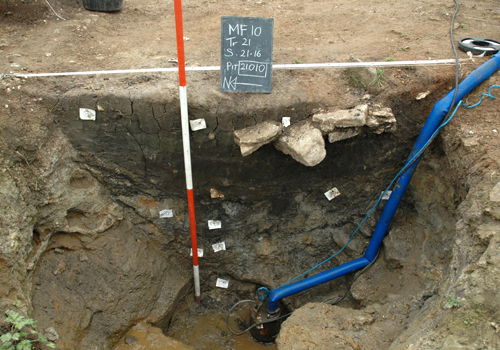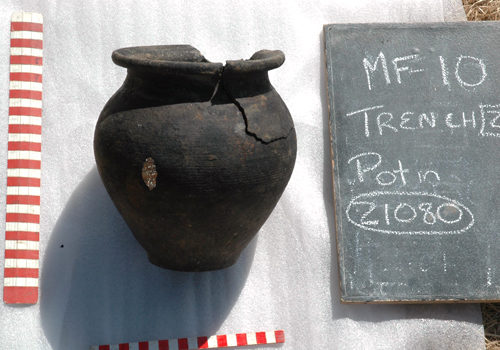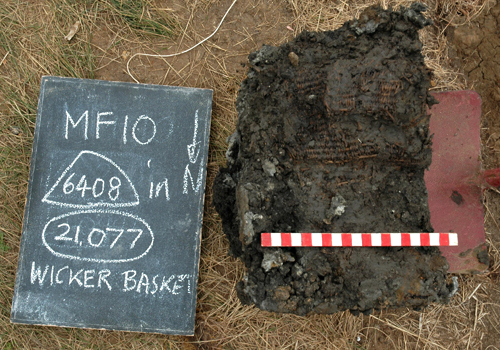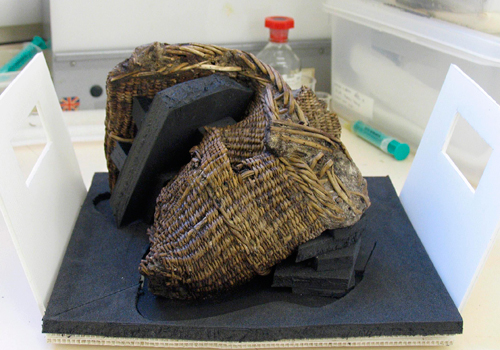Rare Roman basket, shoe in waterlogged pit at Marcham
The Iron-Age settlement and Romano-British temple site at Marcham in Oxfordshire has been the subject of extensive research excavations from 2001-2011 as a collaborative project between the University's Department for Continuing Education and the Institute of Archaeology.
For the whole period the site acted as a training excavation for Continuing Education students and many fascinating features, structures, and finds of both a religious and domestic nature have been revealed. Interim reports can be found at: http://www.arch.ox.ac.uk/VRP1.html
One of the more unusual features discovered was a large waterlogged pit of the Roman period, located at the southern edge of the site away from the main temple and shrine buildings and close to the River Ock, Figure 1.

Figure 1: The pit with half of the fill removed, before the basket was discovered.
In 2006 a complete Roman pot and a worn Roman shoe were found in the pit, the organic material having been perfectly preserved by the anaerobic conditions in the pit which is below the water-table. The pot was a late Roman type and had a large hole in one side, pierced by some form of sharp point (possibly a spear) as a deliberate act.

Figure 2: Roman jar with pierced hole in side.
The shoe is very worn but largely complete, apart from the upper section. The sole is studded with a small amount of hobnails, a modest amount compared to the heavily-nailed military strapped 'caligae' type worn by Roman soldiers. The Marcham shoe had a substantial 'upper', stitched down the middle. It may either have been a 'calceus' type, which largely covered the foot or possibly a 'soccus', which is a low shoe or slipper. In the Roman period 'soccus' were worn by both sexes as a house shoe or slipper. Unfortunately the upper edges of the shoe are so damaged it is uncertain whether the shoe was more of a boot type or a slipper type. The size of the Marcham shoe (250mm long and 90mm wide at widest point) would make it a size 5 to 6 in modern shoe sizes, so it could have belonged either to a small footed man or more likely a woman. Though in the Roman period people may have been generally rather smaller than our modern population, collections of shoes from Roman urban sites like Billingsgate in London, showing a size range from about 155mm in length (child size 5) to about 285mm in length (adult size 12) indicate that our shoe at a modern size 5-6 does not equate with a particularly large adult size in shoes in the Roman period.

Figure 3: The shoe after conservation, showing hobnails worn through to inner sole
Later excavations in the same pit in 2010 revealed another complete Roman pot, also ritually stabbed or 'killed', other fragments of leather and perforated sections of wood, a cow skull, and spectacularly a wooden writing tablet and an almost complete Roman basket. The wooden writing tablet is a rare find outside of the Roman military sites and large urban waterlogged sites. It is the type that would have been filled with melted wax, so that short messages or instructions could be engraved on it by means of a stylus, figure 4.

Figure 4: Wooden writing tablet
It was probably cut-down from a slightly larger tablet and then re-shaped and finished for use, reducing it to a 'post-it note' size as opposed to the original 'post-card' size. The Marcham tablet is a single tablet of modest proportions, recessed on one side only, and very different from the larger tablet types generally used for legal or business documents. Its small size suggests it might have been used for lists or short messages. Who knows - perhaps it was inscribed with a short message to the gods of the place, before being deposited in the watery pit?
Any writing has long since gone with the wax, which doesn't survive, but some tablets can hold faint traces of the original text where it has gone through the wax. In order to check this, an RTI image of the tablet has been taken with a piece of ground-breaking technology currently being tested at the Centre for Ancient Documents, University of Oxford, by Dr. Kathryn Piquette. This Reflectance Transformation Imaging system takes multiple images of an object under an imaging dome studded with 76 LED lights. An image can then be manipulated on a computer and virtually lit from many directions in order to pick out the finest of details. Some faint linear cuts, which may be traces of a few letters of Roman script, are visible on our tablet on the first RTI scan. Further analysis of these images will be done to determine whether any meaningful script can be made out of them.
The Roman basket is another mystery - what was it used for during the life of the Roman temple and its inhabitants and visitors, and why was it deposited in this pit alongside the other objects. Did it contain anything like foodstuffs that would not have survived even in waterlogged conditions? The basket was in a very fragile condition when found, so had to be dug up in a block of soil, then transported in a water-filled container to the York Archaeological Trust Conservation Laboratory, where it was painstakingly extracted from the mud, then conserved. The conservation involved immersing the basket in a varying PEG wax solution for several months to consolidate the organic fibres.

Figure 5: Basket removed in block of soil in 2010 excavations.
A large part of the basket survives, except for its base, and associated with it were thicker wood fragments of young oak, which may represent a handle, and small narrow strap-like pieces, some perforated, which may represent fastening straps for a lid of some kind. Felicity Wood of the Pitt-Rivers Museum and members of the Worshipful Company of Basketmakers have studied the basket with a view to making a modern replica of the piece. Establishing the original shape of the vessel is difficult due to the base being removed and the whole structure warping through time. However it seems probable that it was originally round and drum-shaped, possibly with a fastening lid and possibly with a carrying handle. Dr. Stephen Harris, a plant species expert from Oxford University has established that the uprights or 'stakes' are made from stripped willow, and even the very fine horizontal 'weavers' between them are also made from willow. Today it is impossible to find willow as fine as this for basket-making but it is known from contemporary Roman sources like Pliny that in the Roman period very fine willow was available and deliberately cultivated, much finer than most willow found in Britain today.

Figure 6: The basket after conservation.
The basket is constructed in a close simple twined method with a very fine weave, Figure 6. The upper edge or selvedge edge is a thicker weave and there is a double decorative raised band about half-way down. Interestingly the base has been deliberately sheared or cut off, and an area of the wall has been deliberately cut as well. This may well be another example of a ritual 'killing' of the object, in line with the two damaged pots found in the same pit, as clearly without a base a container cannot function at all, so it was no longer fit for human use. It is interesting that another basket, rather cruder than ours, was found locally in a Roman waterlogged pit at Gill Mill, South Leigh by Oxford Archaeology (pers. comm. Paul Booth, OAU) and it also had a damaged base, in this case by burning. Another site in the region, also currently being excavated by OA, has found a Roman waterlogged pit containing a variety of votive material, including fragments of a basket that appear to have been deliberately stabbed. The Marcham basket's very fine weave, decorative elements and small size suggests it was either for personal use or, given its location, perhaps a basket for storing precious or sacred items in. Similar drum-shaped Roman baskets, some with domed lids, have been found in Roman Gaul and one in Cairo Museum contains compartments for glass medicine bottles. The latter suggests a very interesting possible function for the Marcham basket, which would tie in with other 'healing' aspects of the temple site. We have just received funding from the Worshipful Company of Basket-Makers in order to create a complete replica so we can better understand the basket's construction and original purpose.
In tribal cultures across the world baskets could have a ritual and religious function as well as a practical function. For examples the Ute Indians in Arizona used highly decorated baskets to cover their dead and many of those baskets were deliberately pushed inward at the base so as to end the life of the basket enabling it to accompany the deceased into the spirit world. In ancient cultures in Europe and the near East contemporary writers refer to baskets being used in religious ceremonies as sacred vessels to carry both votive offerings and objects used in the holy rites. Both Greek and Roman texts refer to basket-bearing maidens and priestesses performing key roles in sacred ceremonies. Baskets were used particularly in the worship of Demeter and Dionysus and in initiating people into the Eleusis Mysteries. The sacred basket of Demeter can be seen on various Greek coins. We can only speculate as to whether the Marcham basket originally had some key role in sacred ceremonies on the temple site, before being 'killed' and deposited in the pit.
The waterlogged pit is dated by the pottery types to the late Roman period, and the limited and unusual nature of the objects found in it, strongly suggest that the selection of objects represents some kind of ritual offering. All of the objects discussed here seem to have either been ritually 'killed', a phenomenon seen on many prehistoric and Roman sites, or in the case of the shoe, to have been so worn as to have become non-functional. There are other instances of interesting ritual activities on the Marcham temple site in the late Roman period, at what was effectively the end of its life, including the small group of inhumation burials laid across the eastern entrance to the arena, and a large deposit of late Roman coins found in a narrow shaft surrounded by a small walled structure, a shrine. Does all of this behaviour perhaps represent the last gasp of paganism by local devotees, in the face of the official imperial edict that Christianity should replace the former worship of pagan gods? Or perhaps the offerings in the waterlogged pit and the coin-rich shaft were carried out by Romano-British Christians, who were ceremonially ending the life of the pagan shrines on the site in order to move on to the new worship of the Christian God. As with many of the features on this fascinating site, the discoveries in this pit have shed light on the rituals and ceremonies of our distant past and given us a glimpse of our ancestor's relationship with their gods - whether carried out in stone-built shrines, or in the watery gateways to the underworld in pools and pits and rivers.
Post-excavation work is continuing on the Marcham material, see http://trendlesproject.com/ If you would like more information contact Gary Lock, Sheila Raven or Paula Levick on trendlesproject@gmail.com
Acknowledgments: We would like to thank Gill and Melville Cox of Butler Cox Flooring Ltd, in Abingdon for generously funding the full costs of the conservation of the three objects at the York Archaeological Trust's Conservation Laboratory.
Published 4 February 2013
